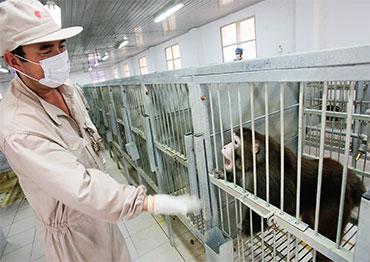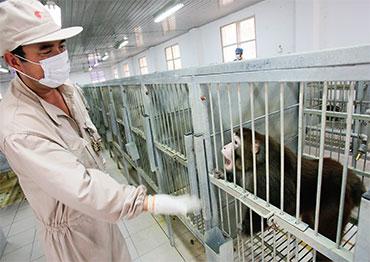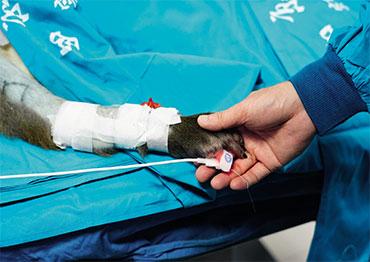Each lab monkey sold in China has an ID number assigned by the breeding farm. Among all lab primates, the long-tailed macaque and the rhesus monkey are mostused in research. According to regulations, each monkey must have detailed genetic and health files. They can be used in research if they test negative for pathogenic microorganisms and they are at least a second-generation artificial (not wild) breeding monkey.
The strict requirements for experimental animals not only ensure the quality of research, but also prolong the supply cycle of experimental monkeys. However, lab monkeys are not available on demand. Monkeys usually take five years to mature, and it may take up to eight years before the first offspring of the breeding monkeys can be sold. “This is the main reason why we have a lab monkey shortage now, and the one that we’ll get three to five years from now,” Zhao said.
Zhang Yuchao, secretary-general of the Primate Breeding Association, told our reporter there is a reserve of some 240,000 lab monkeys in China. Excluding underage monkeys and breeding monkeys, there are around 100,000 in the reserve.
Pre-clinical trials of new drugs make up the greatest domestic demand for lab monkeys, using some 25,000 monkeys a year, mainly long-tailed macaques. Wang Jufeng, senior vice-president of Pharmaron Pharmaceutical in Beijing, told NewsChina that 70 to 80 percent of new drugs need monkeys for pre-clinical trials, while 20 to 30 percent of small molecular drugs, or chemical synthetic drugs, use monkeys for pre-clinical trials.
In general, pre-clinical trials use two species to determine which animal is more sensitive to the drug. Common choices are rodents, such as rats or mice, and animals like monkeys, dogs or piglets. “If both dogs and monkeys meet the test conditions, clinical trials will definitely choose dogs because they are cheaper,” Wang said. “Although the price for lab beagles is also rising to around 3,000 to 4,000 yuan (US$461-615), it’s still only 7 percent of the price for a lab monkey.”
The number of monkeys used in drug preclinical trials varies. On average, 40 monkeys are needed for 28 days of repeated dosages, and about 20 more are needed if drug metabolism tests are required. The rapid development of the biomedical industry is undoubtedly driving demand. According to official statistics, the number of new drug clinical trial applications processed by the Center for Drug Evaluation of National Medical Products Administration (NMPA) increased from 494 in 2014 to 983 in 2019.
According to Li Qin, chief scientist of the Primate Breeding Association, lab monkey use increased from 7,000 in 2013 to nearly 30,000 in 2019. Since 2017, the number of lab monkeys grew by some 10,000 per year, most of which were used in drug development and safety assessments.
There are other reasons for the shortage. Xiong Wanhua, founder of the Primate Breeding Association, told NewsChina that the long-tailed macaque, although accounting for up to 80 to 85 percent of total lab monkey use in China, is a non-native species imported from Southeast Asia. After the 2008 global financial crisis, the export industry for lab monkeys was affected. The stock of lab monkeys in China grew steadily and reached nearly 300,000 in 2013, a record high. This led to the suspension of monkey imports that year.
In 2015, drug supervision reforms that sped up approval processes and trial result evaluations resulted in explosive growth of domestic drug research and development. Lab monkey use also soared, which quickly depleted stocks. In addition, because of the import ban, monkey farms faced aging stocks and dropping fertility rates. In late 2018, the State approved some imports to monkey farms, but these were halted by the outbreak of Covid-19.
On January 26, 2020, China’s State Administration of Market Supervision along with other departments issued the “Notification on Prohibiting Wildlife Transactions,” requiring that “all places where wild animals are kept shall be isolated and all wild animals shall be strictly prohibited from sales or movements [of live animals].” Both imports and exports of lab monkeys were stopped too.
Zhao Shengli said supply of lab monkeys became a problem in 2018, when the price increased to a level beyond what most scientific research groups could afford. The Primate Breeding Association receives many complaints from researchers over the shortage of lab monkeys and the high prices.

 Old Version
Old Version

